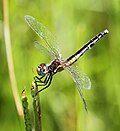Diplacodes
Appearance
| Perchers | |
|---|---|

| |
| Male scarlet percher | |
| Scientific classification | |
| Domain: | Eukaryota |
| Kingdom: | Animalia |
| Phylum: | Arthropoda |
| Class: | Insecta |
| Order: | Odonata |
| Infraorder: | Anisoptera |
| Family: | Libellulidae |
| Subfamily: | Sympetrinae |
| Genus: | Diplacodes Kirby, 1889[1] |
Diplacodes is a genus of dragonflies in the Libellulidae family.[2] They are commonly known as perchers. Their colours range from the totally black body of the African Diplacodes lefebvrii, the lovely pale blue of India's Diplacodes trivialis, to the intense red of the Asian–Australian Diplacodes haematodes.
Various species of this genus occur in Africa, Asia, Australia and the South West Pacific. They are generally small in size.
Species
[edit]The genus Diplacodes includes the following species:[3]
| Male | Female | Scientific name | Common name | Distribution |
|---|---|---|---|---|
 |
 |
Diplacodes bipunctata (Brauer, 1865) | wandering percher[4] | Australia |
| Diplacodes deminuta Lieftinck, 1969 | little percher[5] | Central Africa | ||
 |
Diplacodes exul (Selys, 1883) | Madagascar | ||
 |
 |
Diplacodes haematodes (Burmeister, 1839) | scarlet percher[4] | Australia (except Tasmania), Timor, New Guinea, Vanuatu, and New Caledonia. |
 |
 |
Diplacodes lefebvrii (Rambur, 1842) | black percher[6] | Africa and southern Eurasia. |
 |
Diplacodes luminans (Karsch, 1893) | luminous percher, barbet, barbet percher[7] | Central Africa | |
 |
 |
Diplacodes melanopsis (Martin, 1901) | black-faced percher[4] | Eastern Australia |
 |
 |
Diplacodes nebulosa (Fabricius, 1793) | charcoal-winged percher[4] | Asia and northern Australia |
 |
 |
Diplacodes pumila Dijkstra, 2006 | dwarf percher[8] | Democratic Republic of the Congo, Mozambique, South Africa, Tanzania, Zambia, and Zimbabwe |
| Diplacodes spinulosa Navás, 1915 | Africa | |||
 |
 |
Diplacodes trivialis (Rambur, 1842) | chalky percher,[4] ground skimmer[9] | India |
References
[edit]Wikimedia Commons has media related to Diplacodes.
Wikispecies has information related to Diplacodes.
- ^ Kirby, W.F. (1889). "A revision of the subfamily Libellulinae, with descriptions of new genera and species". Transactions of the Zoological Society of London. 12: 249–348 [307]. doi:10.1111/j.1096-3642.1889.tb00016.x – via Biodiversity Heritage Library.
- ^ "Genus Diplacodes Kirby, 1889". Australian Faunal Directory. Australian Biological Resources Study. 2012. Retrieved 27 February 2017.
- ^ Paulson, D.; Schorr, M.; Abbott, J.; Bota-Sierra, C.; Deliry, C.; Dijkstra, K.-D.; Lozano, F. "World Odonata List". OdonataCentral, University of Alabama.
- ^ a b c d e Günther Theischinger; John Hawking (2006). The complete field guide to dragonflies of Australia. CSIRO Publishing. ISBN 0-643-09073-8.
- ^ Clausnitzer, V.; Dijkstra, K.-D.B.; Suhling, F. (2016). "Diplacodes deminuta". IUCN Red List of Threatened Species. 2016: e.T59863A84817476. doi:10.2305/IUCN.UK.2016-3.RLTS.T59863A84817476.en. Retrieved 12 November 2021.
- ^ "Checklist, English common names". DragonflyPix.com. Archived from the original on 4 December 2012. Retrieved 5 August 2010.
- ^ Clausnitzer, V. (2016). "Diplacodes luminans". IUCN Red List of Threatened Species. 2016: e.T184261A83894418. doi:10.2305/IUCN.UK.2016-3.RLTS.T184261A83894418.en. Retrieved 12 November 2021.
- ^ Clausnitzer, V.; Clausnitzer, V. & Suhling, F. (2010). "Diplacodes pumila". IUCN Red List of Threatened Species. 2010: e.T168013A6442446. doi:10.2305/IUCN.UK.2010-3.RLTS.T168013A6442446.en.
- ^ Subramanian, K. A. (2005). Dragonflies and Damselflies of Peninsular India (PDF).
